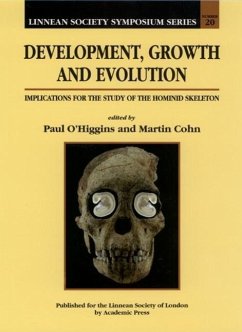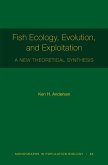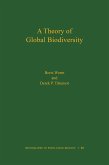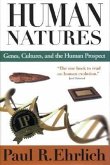Paul O'Higgins / Martin J. Cohn (Volume ed.)
Development, Growth, and Evolution
Implications for the Study of the Hominid Skeleton
Schade – dieser Artikel ist leider ausverkauft. Sobald wir wissen, ob und wann der Artikel wieder verfügbar ist, informieren wir Sie an dieser Stelle.
Paul O'Higgins / Martin J. Cohn (Volume ed.)
Development, Growth, and Evolution
Implications for the Study of the Hominid Skeleton
- Gebundenes Buch
- Merkliste
- Auf die Merkliste
- Bewerten Bewerten
- Teilen
- Produkt teilen
- Produkterinnerung
- Produkterinnerung
This book presents a synthesis of the modern approaches to the study of ontogeny and the interpretation of the fossil evidence for human origins. Recent years have seen significant developments in the understanding of the regulation of embryonic pattern formation and skeletal adaptation, and in techniques for the visualizations and analysis of ontogenetic transformations, offering the prospect of understanding the mechanisms underpinning phylogenetic transformation in the skeleton. Advances in developmental biology, molecular genetics, biomechanics, microscopy, imaging and morphometrics are…mehr
Andere Kunden interessierten sich auch für
![Fish Ecology, Evolution, and Exploitation Fish Ecology, Evolution, and Exploitation]() Ken H AndersenFish Ecology, Evolution, and Exploitation137,99 €
Ken H AndersenFish Ecology, Evolution, and Exploitation137,99 €![A Theory of Global Biodiversity A Theory of Global Biodiversity]() Boris WormA Theory of Global Biodiversity61,99 €
Boris WormA Theory of Global Biodiversity61,99 €![Human Natures: Genes Cultures and the Human Prospect Human Natures: Genes Cultures and the Human Prospect]() Paul R. EhrlichHuman Natures: Genes Cultures and the Human Prospect67,99 €
Paul R. EhrlichHuman Natures: Genes Cultures and the Human Prospect67,99 €![Illustrated Flora of Bambusoideae in China Illustrated Flora of Bambusoideae in China]() Jun Yi ShiIllustrated Flora of Bambusoideae in China596,99 €
Jun Yi ShiIllustrated Flora of Bambusoideae in China596,99 €![What It's Really All About What It's Really All About]() Carl von EssenWhat It's Really All About16,99 €
Carl von EssenWhat It's Really All About16,99 €![Scatter, Adapt, and Remember Scatter, Adapt, and Remember]() Annalee NewitzScatter, Adapt, and Remember19,99 €
Annalee NewitzScatter, Adapt, and Remember19,99 €![Ecological Responses to the 1980 Eruption of Mount St. Helens Ecological Responses to the 1980 Eruption of Mount St. Helens]() Virginia H. Dale / Frederick J. Swanson / Charles M. Crisafulli (eds.)Ecological Responses to the 1980 Eruption of Mount St. Helens36,99 €
Virginia H. Dale / Frederick J. Swanson / Charles M. Crisafulli (eds.)Ecological Responses to the 1980 Eruption of Mount St. Helens36,99 €-
This book presents a synthesis of the modern approaches to the study of ontogeny and the interpretation of the fossil evidence for human origins. Recent years have seen significant developments in the understanding of the regulation of embryonic pattern formation and skeletal adaptation, and in techniques for the visualizations and analysis of ontogenetic transformations, offering the prospect of understanding the mechanisms underpinning phylogenetic transformation in the skeleton. Advances in developmental biology, molecular genetics, biomechanics, microscopy, imaging and morphometrics are brought to bear on the subject. Key Features* Reviews important hot subject areas* Juxtaposes contributions by developmental biologists and those by evolutionary morphologists* Makes some bold insights; synthesizes development and evolution
Produktdetails
- Produktdetails
- Verlag: Elsevier Science
- Seitenzahl: 288
- Erscheinungstermin: 5. April 2000
- Englisch
- Abmessung: 264mm x 185mm x 20mm
- Gewicht: 807g
- ISBN-13: 9780125249652
- ISBN-10: 0125249659
- Artikelnr.: 21814392
- Herstellerkennzeichnung
- Libri GmbH
- Europaallee 1
- 36244 Bad Hersfeld
- gpsr@libri.de
- Verlag: Elsevier Science
- Seitenzahl: 288
- Erscheinungstermin: 5. April 2000
- Englisch
- Abmessung: 264mm x 185mm x 20mm
- Gewicht: 807g
- ISBN-13: 9780125249652
- ISBN-10: 0125249659
- Artikelnr.: 21814392
- Herstellerkennzeichnung
- Libri GmbH
- Europaallee 1
- 36244 Bad Hersfeld
- gpsr@libri.de
Paul O'Higgins began studying medicine at the University of Leeds in 1976. He earned a BSc in Anatomy and developed an interest in primate and human evolution. He returned to complete medical studies, qualifying in 1982. For the next 6 years he pursued his Ph.D. while practicing medicine and lecturing in Anatomy at the University of Leeds. He received his Ph.D. in 1989 and in 1990 was named Senior Lecturer in Anatomy at the University of Western Australia. In 1994 he returned to London where he became a Reader in Anatomy at University College. His focus there is in geometric modelling and comparison of growth in relation to evolution and sexual dimorphism.
Martin Cohn obtained a B.A. in Anthropology from the University of Texas at Austin in 1991. From 1991 through 1993, he carried out research on digit reduction in extant and extinct mammals at Kent State University, earning his Master's Degree. In 1993, he began work on a Ph.D. at University College London where he focused on the molecular mechanisms controlling the initiation of limb development and the positioning of limbs along the head-to-tail axis of vertebrate embryos. He moved to the University of Reading in 1997 as a postdoctoral fellow in evolutionary developmental biology. Since 1998 he has been the BBSRC David Phillips Research Fellow at the University of Reading. His current focus is the origin of fin and limb development, and molecular basis limb loss, in vertebrate evolution.
Martin Cohn obtained a B.A. in Anthropology from the University of Texas at Austin in 1991. From 1991 through 1993, he carried out research on digit reduction in extant and extinct mammals at Kent State University, earning his Master's Degree. In 1993, he began work on a Ph.D. at University College London where he focused on the molecular mechanisms controlling the initiation of limb development and the positioning of limbs along the head-to-tail axis of vertebrate embryos. He moved to the University of Reading in 1997 as a postdoctoral fellow in evolutionary developmental biology. Since 1998 he has been the BBSRC David Phillips Research Fellow at the University of Reading. His current focus is the origin of fin and limb development, and molecular basis limb loss, in vertebrate evolution.
Molecular Control of Vertebrate Limb Development, Evolution, and Congenital
Malformations:
M.J. Cohn and P.E. Bright, Introduction.
Specification and Initiation of Limbs.
Limb Identity: Forelimbs or Hindlimbs?
Outgrowth and Patterning: Generating Bones from Buds.
Hox Genes in Limb Development.
Evolution of Tetrapod Limbs.
Congenital Limb Anomalies: Linking Malformations to Molecules.
Conclusions. Acknowledgments. References.
Biomechanical Influences on Skeletal Growth and Development:
T. Skerry, Introduction.
Functions of the Skeleton.
Historical Perspectives of Mechanical Influences on Bone.
Quantitative Studies on Effects of Loading on Bone.
Responses of Bone Cells to Loading.
Conclusions. Acknowledgments. References.
The Evolution of Mammalian Morphology: A Developmental Perspective:
C.O. Lovejoy, M.J. Cohn and T.D. White, Introduction.
Early Patterning of the Limb Skeleton.
Functional Integration Within the Limb Bud.
Some Implications for the Interpretation of Mammalian Skeletal Evolution.
Conclusions. Acknowledgments. References.
Development and Patterning of the Cranium:
P. Thorogood and T. Schilling.
Ontogeny, Homology, and Phylogeny in the Problem of the Browridge:
D.E. Lieberman.
The Problem: How Do We Retrieve Reliable Information on Phylogeny from the
Skull?
Homology.
Integrating Homology and Development.
How Do We Study Processes of Hominid Cranial Development? Example: The
Browridge.
Conclusion. Acknowledgments. Appendix. References.
Imaging Skeletal Growth and Evolution:
F. Spoor, N. Jeffery and F. Zonneveld, Overview.
Introduction.
Plain Film Radiography.
Computed Tomography.
Micro-CT/X-ray Microtomograpy.
Magnetic Resonance.
High Resolution Magnetic Resonance Imaging.
Three Dimensional Imaging.
Quantitative Analysis.
Working With Images.
Future Prospects.
Acknowledgments. References.
Appendix: Glossary of Imaging Terms.
Quantitative Approaches to the Study of Craniofacial Growth and Evolution:
Advances in Morphometric Techniques:
P. O'Higgins, Growth and Evolution of the Face: Motivation. Analysing and
Modelling Morphological Transformations in Growth and Evolution.
Quantifying Morphology.
Variations in Size and Shape.
Geometric Analyses of Cranial Variation in Primates.
Growth and Evolution of the Face: Prospect.
Acknowledgments. Software. References.
Interpreting the Hominid Dentition: Ontogenetic and Phylogenetic Aspects:
G.T. Schwartz and C. Dean, Introduction.
Tooth Formation and the Development of Crown Morphology.
Incremental Markings in Enamel and Dentine.
Evidence for the Periodicity of Circadian and Longer Period Incremental
Markings.
Using Incremental Markings to Study Growth in Fossil Teeth.
Phylogenetic Scenarios for the Evolution of Thick Enamel.
Cuspal Enamel Growth.
Dental Development Schedules in Hominoids.
Life History and Primate Evolution.
Summary. Acknowledgments. References. Glossary.
Morphometrics of the Primate Skeleton and the Functional and Developmental
Underpinnings of Species Diversity:
C.E. Oxnard, Introduction.
Morphometric Studies of Individual Functional Units.
Morphometric Studies of Integrated Combinations of Functional Units.
Masticatory System: Function, Development and Evolution.
Locomotor System: Function, Development and Evolution.
Studies of the Niche:"Function" and "Evolution."
Studies of the Brain: "Neurometrics." Summary of Results from Clusters of
Variables.
Theoretical Information Content of Data Sets.
Conclusions. Acknowledgments. References.
Malformations:
M.J. Cohn and P.E. Bright, Introduction.
Specification and Initiation of Limbs.
Limb Identity: Forelimbs or Hindlimbs?
Outgrowth and Patterning: Generating Bones from Buds.
Hox Genes in Limb Development.
Evolution of Tetrapod Limbs.
Congenital Limb Anomalies: Linking Malformations to Molecules.
Conclusions. Acknowledgments. References.
Biomechanical Influences on Skeletal Growth and Development:
T. Skerry, Introduction.
Functions of the Skeleton.
Historical Perspectives of Mechanical Influences on Bone.
Quantitative Studies on Effects of Loading on Bone.
Responses of Bone Cells to Loading.
Conclusions. Acknowledgments. References.
The Evolution of Mammalian Morphology: A Developmental Perspective:
C.O. Lovejoy, M.J. Cohn and T.D. White, Introduction.
Early Patterning of the Limb Skeleton.
Functional Integration Within the Limb Bud.
Some Implications for the Interpretation of Mammalian Skeletal Evolution.
Conclusions. Acknowledgments. References.
Development and Patterning of the Cranium:
P. Thorogood and T. Schilling.
Ontogeny, Homology, and Phylogeny in the Problem of the Browridge:
D.E. Lieberman.
The Problem: How Do We Retrieve Reliable Information on Phylogeny from the
Skull?
Homology.
Integrating Homology and Development.
How Do We Study Processes of Hominid Cranial Development? Example: The
Browridge.
Conclusion. Acknowledgments. Appendix. References.
Imaging Skeletal Growth and Evolution:
F. Spoor, N. Jeffery and F. Zonneveld, Overview.
Introduction.
Plain Film Radiography.
Computed Tomography.
Micro-CT/X-ray Microtomograpy.
Magnetic Resonance.
High Resolution Magnetic Resonance Imaging.
Three Dimensional Imaging.
Quantitative Analysis.
Working With Images.
Future Prospects.
Acknowledgments. References.
Appendix: Glossary of Imaging Terms.
Quantitative Approaches to the Study of Craniofacial Growth and Evolution:
Advances in Morphometric Techniques:
P. O'Higgins, Growth and Evolution of the Face: Motivation. Analysing and
Modelling Morphological Transformations in Growth and Evolution.
Quantifying Morphology.
Variations in Size and Shape.
Geometric Analyses of Cranial Variation in Primates.
Growth and Evolution of the Face: Prospect.
Acknowledgments. Software. References.
Interpreting the Hominid Dentition: Ontogenetic and Phylogenetic Aspects:
G.T. Schwartz and C. Dean, Introduction.
Tooth Formation and the Development of Crown Morphology.
Incremental Markings in Enamel and Dentine.
Evidence for the Periodicity of Circadian and Longer Period Incremental
Markings.
Using Incremental Markings to Study Growth in Fossil Teeth.
Phylogenetic Scenarios for the Evolution of Thick Enamel.
Cuspal Enamel Growth.
Dental Development Schedules in Hominoids.
Life History and Primate Evolution.
Summary. Acknowledgments. References. Glossary.
Morphometrics of the Primate Skeleton and the Functional and Developmental
Underpinnings of Species Diversity:
C.E. Oxnard, Introduction.
Morphometric Studies of Individual Functional Units.
Morphometric Studies of Integrated Combinations of Functional Units.
Masticatory System: Function, Development and Evolution.
Locomotor System: Function, Development and Evolution.
Studies of the Niche:"Function" and "Evolution."
Studies of the Brain: "Neurometrics." Summary of Results from Clusters of
Variables.
Theoretical Information Content of Data Sets.
Conclusions. Acknowledgments. References.
Molecular Control of Vertebrate Limb Development, Evolution, and Congenital
Malformations:
M.J. Cohn and P.E. Bright, Introduction.
Specification and Initiation of Limbs.
Limb Identity: Forelimbs or Hindlimbs?
Outgrowth and Patterning: Generating Bones from Buds.
Hox Genes in Limb Development.
Evolution of Tetrapod Limbs.
Congenital Limb Anomalies: Linking Malformations to Molecules.
Conclusions. Acknowledgments. References.
Biomechanical Influences on Skeletal Growth and Development:
T. Skerry, Introduction.
Functions of the Skeleton.
Historical Perspectives of Mechanical Influences on Bone.
Quantitative Studies on Effects of Loading on Bone.
Responses of Bone Cells to Loading.
Conclusions. Acknowledgments. References.
The Evolution of Mammalian Morphology: A Developmental Perspective:
C.O. Lovejoy, M.J. Cohn and T.D. White, Introduction.
Early Patterning of the Limb Skeleton.
Functional Integration Within the Limb Bud.
Some Implications for the Interpretation of Mammalian Skeletal Evolution.
Conclusions. Acknowledgments. References.
Development and Patterning of the Cranium:
P. Thorogood and T. Schilling.
Ontogeny, Homology, and Phylogeny in the Problem of the Browridge:
D.E. Lieberman.
The Problem: How Do We Retrieve Reliable Information on Phylogeny from the
Skull?
Homology.
Integrating Homology and Development.
How Do We Study Processes of Hominid Cranial Development? Example: The
Browridge.
Conclusion. Acknowledgments. Appendix. References.
Imaging Skeletal Growth and Evolution:
F. Spoor, N. Jeffery and F. Zonneveld, Overview.
Introduction.
Plain Film Radiography.
Computed Tomography.
Micro-CT/X-ray Microtomograpy.
Magnetic Resonance.
High Resolution Magnetic Resonance Imaging.
Three Dimensional Imaging.
Quantitative Analysis.
Working With Images.
Future Prospects.
Acknowledgments. References.
Appendix: Glossary of Imaging Terms.
Quantitative Approaches to the Study of Craniofacial Growth and Evolution:
Advances in Morphometric Techniques:
P. O'Higgins, Growth and Evolution of the Face: Motivation. Analysing and
Modelling Morphological Transformations in Growth and Evolution.
Quantifying Morphology.
Variations in Size and Shape.
Geometric Analyses of Cranial Variation in Primates.
Growth and Evolution of the Face: Prospect.
Acknowledgments. Software. References.
Interpreting the Hominid Dentition: Ontogenetic and Phylogenetic Aspects:
G.T. Schwartz and C. Dean, Introduction.
Tooth Formation and the Development of Crown Morphology.
Incremental Markings in Enamel and Dentine.
Evidence for the Periodicity of Circadian and Longer Period Incremental
Markings.
Using Incremental Markings to Study Growth in Fossil Teeth.
Phylogenetic Scenarios for the Evolution of Thick Enamel.
Cuspal Enamel Growth.
Dental Development Schedules in Hominoids.
Life History and Primate Evolution.
Summary. Acknowledgments. References. Glossary.
Morphometrics of the Primate Skeleton and the Functional and Developmental
Underpinnings of Species Diversity:
C.E. Oxnard, Introduction.
Morphometric Studies of Individual Functional Units.
Morphometric Studies of Integrated Combinations of Functional Units.
Masticatory System: Function, Development and Evolution.
Locomotor System: Function, Development and Evolution.
Studies of the Niche:"Function" and "Evolution."
Studies of the Brain: "Neurometrics." Summary of Results from Clusters of
Variables.
Theoretical Information Content of Data Sets.
Conclusions. Acknowledgments. References.
Malformations:
M.J. Cohn and P.E. Bright, Introduction.
Specification and Initiation of Limbs.
Limb Identity: Forelimbs or Hindlimbs?
Outgrowth and Patterning: Generating Bones from Buds.
Hox Genes in Limb Development.
Evolution of Tetrapod Limbs.
Congenital Limb Anomalies: Linking Malformations to Molecules.
Conclusions. Acknowledgments. References.
Biomechanical Influences on Skeletal Growth and Development:
T. Skerry, Introduction.
Functions of the Skeleton.
Historical Perspectives of Mechanical Influences on Bone.
Quantitative Studies on Effects of Loading on Bone.
Responses of Bone Cells to Loading.
Conclusions. Acknowledgments. References.
The Evolution of Mammalian Morphology: A Developmental Perspective:
C.O. Lovejoy, M.J. Cohn and T.D. White, Introduction.
Early Patterning of the Limb Skeleton.
Functional Integration Within the Limb Bud.
Some Implications for the Interpretation of Mammalian Skeletal Evolution.
Conclusions. Acknowledgments. References.
Development and Patterning of the Cranium:
P. Thorogood and T. Schilling.
Ontogeny, Homology, and Phylogeny in the Problem of the Browridge:
D.E. Lieberman.
The Problem: How Do We Retrieve Reliable Information on Phylogeny from the
Skull?
Homology.
Integrating Homology and Development.
How Do We Study Processes of Hominid Cranial Development? Example: The
Browridge.
Conclusion. Acknowledgments. Appendix. References.
Imaging Skeletal Growth and Evolution:
F. Spoor, N. Jeffery and F. Zonneveld, Overview.
Introduction.
Plain Film Radiography.
Computed Tomography.
Micro-CT/X-ray Microtomograpy.
Magnetic Resonance.
High Resolution Magnetic Resonance Imaging.
Three Dimensional Imaging.
Quantitative Analysis.
Working With Images.
Future Prospects.
Acknowledgments. References.
Appendix: Glossary of Imaging Terms.
Quantitative Approaches to the Study of Craniofacial Growth and Evolution:
Advances in Morphometric Techniques:
P. O'Higgins, Growth and Evolution of the Face: Motivation. Analysing and
Modelling Morphological Transformations in Growth and Evolution.
Quantifying Morphology.
Variations in Size and Shape.
Geometric Analyses of Cranial Variation in Primates.
Growth and Evolution of the Face: Prospect.
Acknowledgments. Software. References.
Interpreting the Hominid Dentition: Ontogenetic and Phylogenetic Aspects:
G.T. Schwartz and C. Dean, Introduction.
Tooth Formation and the Development of Crown Morphology.
Incremental Markings in Enamel and Dentine.
Evidence for the Periodicity of Circadian and Longer Period Incremental
Markings.
Using Incremental Markings to Study Growth in Fossil Teeth.
Phylogenetic Scenarios for the Evolution of Thick Enamel.
Cuspal Enamel Growth.
Dental Development Schedules in Hominoids.
Life History and Primate Evolution.
Summary. Acknowledgments. References. Glossary.
Morphometrics of the Primate Skeleton and the Functional and Developmental
Underpinnings of Species Diversity:
C.E. Oxnard, Introduction.
Morphometric Studies of Individual Functional Units.
Morphometric Studies of Integrated Combinations of Functional Units.
Masticatory System: Function, Development and Evolution.
Locomotor System: Function, Development and Evolution.
Studies of the Niche:"Function" and "Evolution."
Studies of the Brain: "Neurometrics." Summary of Results from Clusters of
Variables.
Theoretical Information Content of Data Sets.
Conclusions. Acknowledgments. References.








